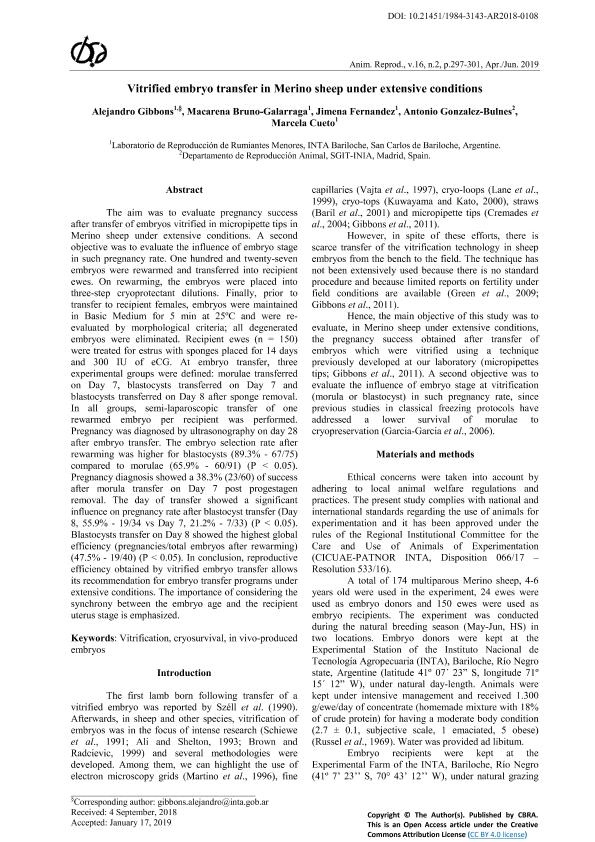Mostrar el registro sencillo del ítem
dc.contributor.author
Gibbons, Alejandro Eduardo

dc.contributor.author
Fernandez, Jimena

dc.contributor.author
Bruno Galarraga, María Macarena

dc.contributor.author
González Bulnes, Antonio
dc.contributor.author
Cueto, Marcela Isabel

dc.date.available
2020-09-16T13:37:17Z
dc.date.issued
2019-06
dc.identifier.citation
Gibbons, Alejandro Eduardo; Fernandez, Jimena; Bruno Galarraga, María Macarena; González Bulnes, Antonio; Cueto, Marcela Isabel; Vitrified embryo transfer in Merino sheep under extensive conditions; Colégio Brasileiro de Reproducao Animal; Animal Reproduction; 16; 2; 6-2019; 297-301
dc.identifier.issn
1806-9614
dc.identifier.uri
http://hdl.handle.net/11336/114088
dc.description.abstract
The aim was to evaluate pregnancy success after transfer of embryos vitrified in micropipette tips in Merino sheep under extensive conditions. A second objective was to evaluate the influence of embryo stage in such pregnancy rate. One hundred and twenty-seven embryos were rewarmed and transferred into recipient ewes. On rewarming, the embryos were placed into three-step cryoprotectant dilutions. Finally, prior to transfer to recipient females, embryos were maintained in Basic Medium for 5 min at 25ºC and were re-evaluated by morphological criteria; all degenerated embryos were eliminated. Recipient ewes (n = 150) were treated for estrus with sponges placed for 14 days and 300 IU of eCG. At embryo transfer, three experimental groups were defined: morulae transferred on Day 7, blastocysts transferred on Day 7 and blastocysts transferred on Day 8 after sponge removal. In all groups, semi-laparoscopic transfer of one rewarmed embryo per recipient was performed. Pregnancy was diagnosed by ultrasonography on day 28 after embryo transfer. The embryo selection rate after rewarming was higher for blastocysts (89.3% - 67/75) compared to morulae (65.9% - 60/91) (P < 0.05). Pregnancy diagnosis showed a 38.3% (23/60) of success after morula transfer on Day 7 post progestagen removal. The day of transfer showed a significant influence on pregnancy rate after blastocyst transfer (Day 8, 55.9% - 19/34 vs Day 7, 21.2% - 7/33) (P < 0.05). Blastocysts transfer on Day 8 showed the highest global efficiency (pregnancies/total embryos after rewarming) (47.5% - 19/40) (P < 0.05). In conclusion, reproductive efficiency obtained by vitrified embryo transfer allows its recommendation for embryo transfer programs under extensive conditions. The importance of considering the synchrony between the embryo age and the recipient uterus stage is emphasized.
dc.format
application/pdf
dc.language.iso
eng
dc.publisher
Colégio Brasileiro de Reproducao Animal
dc.rights
info:eu-repo/semantics/openAccess
dc.rights.uri
https://creativecommons.org/licenses/by/2.5/ar/
dc.subject
VITRIFICATION
dc.subject
CRYOSURVIVAL
dc.subject
IN VIVO PRODUCED EMBRYOS
dc.subject.classification
Ciencias Veterinarias

dc.subject.classification
Ciencias Veterinarias

dc.subject.classification
CIENCIAS AGRÍCOLAS

dc.title
Vitrified embryo transfer in Merino sheep under extensive conditions
dc.type
info:eu-repo/semantics/article
dc.type
info:ar-repo/semantics/artículo
dc.type
info:eu-repo/semantics/publishedVersion
dc.date.updated
2020-06-30T17:56:40Z
dc.identifier.eissn
1984-3143
dc.journal.volume
16
dc.journal.number
2
dc.journal.pagination
297-301
dc.journal.pais
Brasil

dc.journal.ciudad
Belo Horizonte
dc.description.fil
Fil: Gibbons, Alejandro Eduardo. Instituto Nacional de Tecnología Agropecuaria. Centro Regional Patagonia Norte. Estación Experimental Agropecuaria San Carlos de Bariloche. Instituto de Investigaciones Forestales y Agropecuarias Bariloche. - Consejo Nacional de Investigaciones Científicas y Técnicas. Centro Científico Tecnológico Conicet - Patagonia Norte. Instituto de Investigaciones Forestales y Agropecuarias Bariloche; Argentina
dc.description.fil
Fil: Fernandez, Jimena. Instituto Nacional de Tecnología Agropecuaria. Centro Regional Patagonia Norte. Estación Experimental Agropecuaria San Carlos de Bariloche. Instituto de Investigaciones Forestales y Agropecuarias Bariloche. - Consejo Nacional de Investigaciones Científicas y Técnicas. Centro Científico Tecnológico Conicet - Patagonia Norte. Instituto de Investigaciones Forestales y Agropecuarias Bariloche; Argentina
dc.description.fil
Fil: Bruno Galarraga, María Macarena. Instituto Nacional de Tecnología Agropecuaria. Centro Regional Patagonia Norte. Estación Experimental Agropecuaria San Carlos de Bariloche. Instituto de Investigaciones Forestales y Agropecuarias Bariloche. - Consejo Nacional de Investigaciones Científicas y Técnicas. Centro Científico Tecnológico Conicet - Patagonia Norte. Instituto de Investigaciones Forestales y Agropecuarias Bariloche; Argentina
dc.description.fil
Fil: González Bulnes, Antonio. Instituto Nacional de Investigación y Tecnología Agraria y Alimentaria; España
dc.description.fil
Fil: Cueto, Marcela Isabel. Instituto Nacional de Tecnología Agropecuaria. Centro Regional Patagonia Norte. Estación Experimental Agropecuaria San Carlos de Bariloche. Instituto de Investigaciones Forestales y Agropecuarias Bariloche. - Consejo Nacional de Investigaciones Científicas y Técnicas. Centro Científico Tecnológico Conicet - Patagonia Norte. Instituto de Investigaciones Forestales y Agropecuarias Bariloche; Argentina
dc.journal.title
Animal Reproduction
dc.relation.alternativeid
info:eu-repo/semantics/altIdentifier/url/https://www.animal-reproduction.org/article/doi/10.21451/1984-3143-AR2018-0108
dc.relation.alternativeid
info:eu-repo/semantics/altIdentifier/doi/http://dx.doi.org/10.21451/1984-3143-AR2018-0108
Archivos asociados
